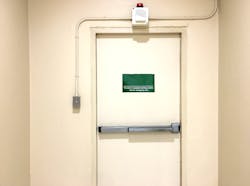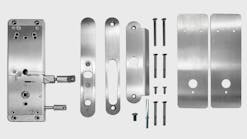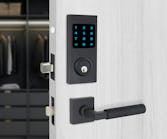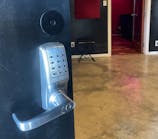Potential violence within the halls of a normal healthcare facility has been a growing reality over the past decade, but incidents have increased substantially over the past 20 months as fears from COVID-19 continue. A recent report in EHS Today states that “three-quarters of all workplace assaults occur in the healthcare industry, and workplace violence is even more prevalent in mental health; almost one in five patients admitted to acute psychiatric units may commit an act of violence.”
The report warns that patients might be in as much danger as hospital staff when considering violence within mental health facilities. “Patients are at risk if another patient brings in or obtains a weapon or other restricted item while in a facility, and this can create a multiplier effect in which patients try to bring their own weapons in, thinking they need to protect themselves from others.”
Locksmith Ledger recently discussed the issues of security and safety in behavioral health facilities with several industry experts. The participants include Christine Cicchetti, product manager for hinges and behavioral health access solutions, and Grant Heppes, distribution development manager for electronic access and data, at dormakaba; Mark Berger, president of Securitech Group; William Sporre, vice president of national and international sales and marketing at Marks USA; Tom Morgan, director of business development—healthcare at ASSA ABLOY Opening Solutions; and John Truempy, an institutional locksmith and the first president of ALOA’s division for institutional locksmiths.
Because of the magnitude of the subject matter and quality of the discussion, we broke up this roundtable. The second part will run in March.
Q: What does the security pro have to know about providing security and safety at behavioral health facilities?
Christine Cicchetti/Grant Heppes: First and foremost, no access device can replace staff supervision fully. The door is a tool that supports nurses and other staff as they respond to the specialized needs of behavioral healthcare patients.
Next, the healthcare industry views behavioral patient care, including safety, from a holistic perspective. Security pros must consider the options for doors and closers from both sides of the opening. Access control solutions must protect the safety of patients and staff from a ligature standpoint while supporting a healing environment. This requires coordination of all aspects of any behavioral healthcare environment, including sound, aesthetics, lighting and security.
The trend is for a less institutional feel to help to reduce patient fear, anxiety and sense of being overwhelmed. The more products that security pros can offer that look more homelike rather than unique to behavioral health, the more likely access products can contribute to a better patient experience. This might sound easy, but the overall evolution won’t occur overnight. A high number of behavioral healthcare facilities have been slow to modernize their sites because of budget constraints.
Mark Berger: Security pros have been trained to provide solutions to protect against forced entries. The cream of the crop understands codes and maintaining single-motion egress. Code requirements for panic bars and the necessity for alarmed exit locks have been important elements of many locksmith businesses.
To succeed in the behavioral healthcare world, you have to forget all that. You no longer are concerned about people breaking in, and providing single-motion egress isn’t a factor in an occupancy classification that allows locked wards. Where previously you might have interfaced with a facility manager, security director or owner, you’ll now take direction from operational staff, including doctors and nurses, who will guide you through the unique requirements.
Where to start? There are guiding documents, such as the New York State Office of Mental Health’s (OMH) Patient Safety Standard Guidelines. It’s published twice a year and free to download, and it’s a collection of tested products that includes excellent commentary. Another excellent resource is the Behavioral Health Design Guide, now in its 24th revision and update. It also includes a safety risk-assessment tool to align with The Joint Commission’s recommendations. Understanding The Joint Commission’s goals and requirements is critical to being a valued supplier and professional in this space. Facilities must bring themselves up to The Joint Commission’s standards to continue receiving reimbursement from the government. If a facility isn’t accredited, that spigot is turned off.
These are the keys to understanding the universe. You’re entering a space where protecting patient life by eliminating the opportunity to self-harm is part of every decision.
William Sporre: One important factor is that the ligature-resistant lockset market is evolving constantly. New product that increases the safety of the hardware continues to be developed. As product is used in the field, changes are required to increase ligature resistance. Keeping in contact with the Builders Hardware Manufacturers Association (BHMA) rating of ligature requirements as well as the testing of manufacturers’ products through BHMA and New York OMH will keep the security pro updated on new product as well as ratings on existing product in the field.
Tom Morgan: Whether it’s a behavioral health clinic, crisis intervention facility or a detention center, thoughtful and deliberate planning is required when securing a behavioral-health environment. Each behavioral and mental health facility is different, and each faces its own challenges, particularly when it comes to selecting the right doors, hardware and access control. Factors such as the treatment spaces, the severity of the behavioral condition, gender and risk of harm are important considerations when assessing the requirements of the behavioral-health space.
Several resources are available, but it’s important to work with your local authority having jurisdiction (AHJ) to understand what the local and state regulatory requirements are for the legal standards of care that you’re required to follow. The NFPA 101 Life Safety Code, for example, is a suggested resource for determining code requirements for new and existing healthcare structures, but there are specific exceptions for behavioral health facilities because of their unique occupancy. Your AHJ will be able to help guide you through the requirements to ensure a safe, secure and compliant facility.
John Truempy: These types of facilities are complex with various levels of people [who are] voluntary compared to involuntary commitment, just to start. The facilities seldom rise to the level of prison, but some could. Each state also has different rules. I started my institutional career at the state-run psychiatric hospital, and even that was divided into levels depending on whether the patient was guilty by reason of insanity or insane but unable to stand trial, or a bunch of other conditions even down to age and health.
Is it a stand-alone facility or a ward in a hospital? If it’s just a unit in a hospital you may have to deal with The Joint Commission that accredits 22,000 U.S. healthcare facilities. You might have to keep the patient in and still meet local fire codes. It’s an odd mix. Normal security is trying to keep a bad person out. Prisons try to keep a bad person in. Mix it all together where you have to keep the public out. You might have to keep a person in so they don’t hurt others, and that same person might be the biggest threat to themself.
Q. How do security pros make themselves smarter about ligature resistance and other safety issues and requirements?
Cicchetti/Heppes: Behavioral healthcare access control needs are site-specific. It’s important to work with a professional supplier that can configure a holistic solution that integrates traditional and electronic keys for the best results. Access control manufacturers typically have the best information about their products on their website.
Manufacturers typically have a wide range of digital, self-guided and in-person training opportunities to help security pros to stay on top of best practices and trends. Forward-thinking facilities will work with a manufacturer ahead of any Joint Commission review to audit their site and identify areas for improvement. This provides a roadmap that serves as a head start for upgrade and compliance budgeting and implementation.
Berger: Manufacturers do an excellent job of providing education on their offerings. Bookmark the pages of different manufacturers and make a point of visiting every so often to see what’s new. Hopefully, trade shows will return, and a few are dedicated to the mental-health space. Visit them to see the full breadth of product offerings in the space, not only the door hardware and alarm products that are shown.
Sporre: A few sites are directed towards ligature-resistance hardware, such as New York State OMH as well as BHMA. The OMH website shows a wide range of product, as well as descriptions and pictures.
Morgan: Part of creating a safe and secure behavioral-health environment is selecting the right doors and hardware to protect patients from harm and maintain a level of security for others, including staff and visitors. Although there are no universally mandated standards for doors and hardware for behavioral- and mental-health environments, regulations, codes and guidelines will help to guide product selection. Be sure to check out local and state regulatory requirements, and work with your local AHJ to ensure you’re in compliance. When assessing the requirements of a behavioral or mental health facility, key safety considerations include:
- Looping opportunities. Standard door hardware, such as hinges, closers, locksets and levers might give patients possible ligature points.
- Hanging devices. Opportunities abound for a patient to hold an object, tie a sleeve or sheet knot and create a makeshift, but effective, hanging device.
- Tampering possibilities. Opportunities for patients to tamper gasketing, closures and door fasteners to gain outside access are present.
Truempy: Reading, reading and more reading. Read outside of the normal industry papers. Read white papers. Many government or large institutions have plans and bids posted that you can review for what others did.
Don’t follow the hype or sales pitch. Assume the rest of the design team just did an operating room or an office building last, and they just got this dumped on them. Ask questions, and then think and ask more. Try to find that hidden expert, such as the nurse who has worked 25 years in psych care who will tell you more about potential problems than an architect ever will, because they have to know a little of everything and they aren’t thinking about just doors. If you’re in the commercial world, call your distributor and have them introduce you to an institutional locksmith who works in a hospital that has a psych ward.







